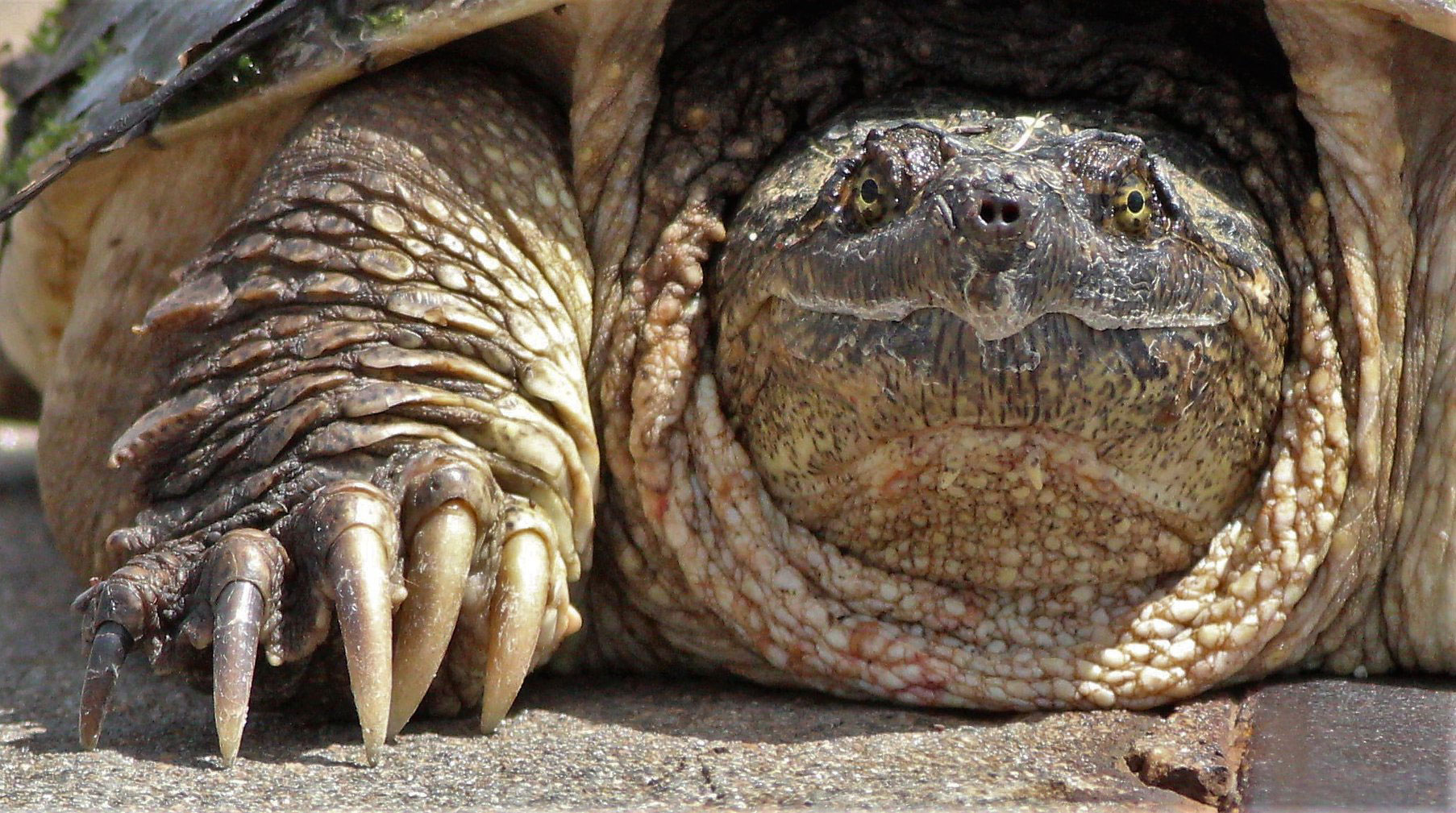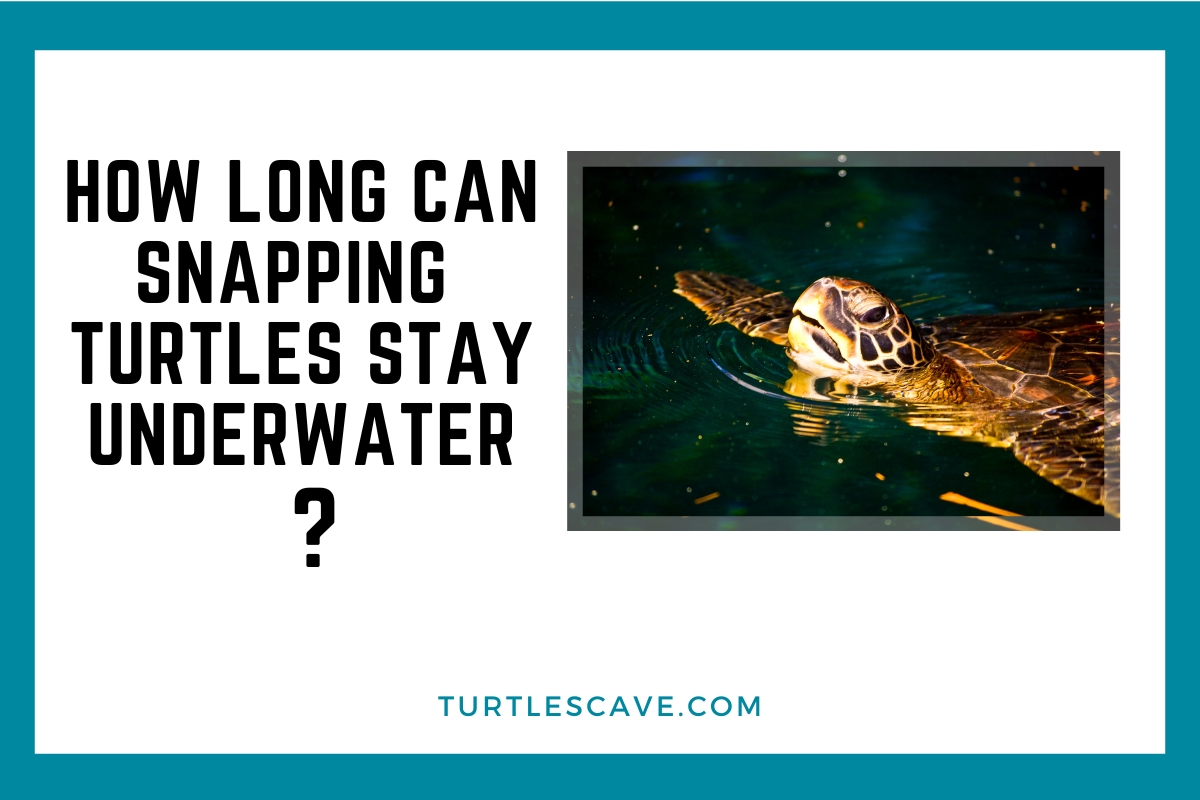Snapping turtles can stay underwater for up to 45 minutes at a time. Snapping turtles are a species of turtles well-known for their aggressive nature and large size.
How long can snapping turtles stay underwater?
Well, let’s just say they give Olympic swimmers a run for their money. These prehistoric-looking creatures are known for their impressive diving abilities, but just how long can they hold their breath? The short answer: a lot longer than you might think.
But the reasons behind their underwater prowess are even more fascinating.
Keep reading to discover the secrets of these aquatic marvels.

Credit: www.reconnectwithnature.org
The Anatomy Of Snapping Turtles
Snapping turtles are fascinating creatures that have a unique ability to stay underwater for lengthy periods. These turtles belong to the Chelydridae family and are commonly found in north America. Their impressive underwater stamina can be attributed to their anatomical structure and special respiratory system.
We will discuss the physical features and respiratory adaptations of snapping turtles that enable them to stay underwater for extended periods.
Description Of The Physical Features And Adaptations Of Snapping Turtles
- Snapping turtles have a heavy, muscular body covered with a prominent, ridge-like carapace.
- They have powerful, strong jaws with sharp, hooked beaks that allow them to capture prey efficiently.
- Their claws are sharp and long, and their legs are sturdy and muscular.
- Snapping turtles have webbed feet, which not only allow them to swim well but also help them move on land.
- They have a tough skin that can withstand bites from other animals or predators.
- The presence of fat deposits in their body provides buoyancy underwater.
- The powerful muscles in their hind legs help them swim faster in water.
Highlight The Importance Of These Adaptations In Their Ability To Stay Underwater
- The prominent, ridge-like carapace provides protection and stability underwater, making it easier for the snapping turtle to swim.
- The strong, sharp jaws allow the snapping turtle to capture prey quickly and efficiently while underwater.
- The webbed feet enable the snapping turtle to swim faster and more effectively in water, while the fat deposits provide buoyancy and make it easier for them to stay submerged.
- The tough skin protects them from any potential injuries while underwater, and the muscular legs help in propelling their body forward.
Discuss The Respiratory System Of Snapping Turtles
- Snapping turtles have developed a unique respiratory system—an adaptation to their semi-aquatic lifestyle—allowing them to stay underwater for longer periods.
- They possess the ability to breathe through their skin, mainly in areas where the skin is in direct contact with the environment.
- They can also extract oxygen from water using their pharyngeal tissues that are present in their throat area.
- Snapping turtles can hold their breath for up to 45 minutes while underwater.
Snapping turtles have unique physical features and respiratory adaptations that help them stay underwater for extended periods. These adaptations and anatomical structures enhance their survival skills in their natural habitat. The next time you come across a snapping turtle, take a moment to appreciate the incredible adaptations that allow this amazing creature to thrive.
Underwater Behaviour Of Snapping Turtles
Snapping turtles are known for their prehistoric appearance, sharp beaks and long tails, but these extraordinary creatures are also fascinating when it comes to their behaviour underwater. Here is a closer look at their underwater behaviour to provide more insight.
In-Depth Discussion Of Snapping Turtles’ Behaviour Underwater
Hunting Techniques
Snapping turtles are well adapted to living in freshwater environments and taking advantage of their resources. They make excellent predators as they have razor-sharp beaks to tear through their prey, and they are also known to undertake foraging on prey bigger than themselves by lying in wait on the bottom of the waterbody.
Staying Underwater Aids Hunting
Snapping turtles’ ability to hold their breath for long periods allows them to stalk their prey without raising suspicion, hereby maximizing their hunting success rates. They also sometimes rely on opportunistic feeding and scavenging by snapping when anything comes in the range of their powerful jaws.
Examples Of Observed Behaviour
Here are some observed behaviours of snapping turtles underwater:
- Snapping turtles can remain submerged for up to 45-50 minutes at a stretch.
- They swim with powerful strokes of their front legs
- They often stay in the deeper sections of the water and surface frequently for air or when the habitat is deemed too shallow.
- They generally swim in short bursts with quick, jerky motions, and when they reach the bottom, they rely on their powerful legs and claws to move on the substrate.
Snapping turtles are skilled predators, and their unique underwater behaviour gives them the advantage they need to hunt effectively. Their ability to hold their breath for long periods enables them to stalk prey without raising suspicion. Understanding their underwater behaviour is a fascinating study that gives insight into these remarkable creatures’ exceptional adaptations.
Factors Affecting Snapping Turtles’ Ability To Stay Underwater
Factors That Contribute To How Long Snapping Turtles Can Stay Underwater
Snapping turtles are fascinating creatures that are well at home in aquatic environments. Despite their bulky appearance, these animals are highly adapted to life underwater, with their strong necks and legs that allow them to move swiftly in the water.
However, several factors affect their ability to stay underwater, including water temperature, dissolved oxygen levels, and water quality.
Effect Of Water Temperature
Water temperature plays a crucial role in how long snapping turtles can stay underwater. When the water temperature is low, their metabolism slows down, causing them to breathe less frequently. This, in turn, allows them to stay underwater for more extended periods.
Conversely, when the water temperature is high, their metabolism speeds up, and they need to breathe more often, reducing the amount of time they can stay submerged.
Dissolved Oxygen Levels
Dissolved oxygen levels are critical for the survival of aquatic animals, including snapping turtles. When the dissolved oxygen levels in the water are low, the turtles have to come up to the surface more frequently to breathe. This reduces the amount of time they can stay underwater.
Water Quality
Poor water quality also affects snapping turtles’ ability to stay underwater. When the water is polluted or has high levels of toxins, it can cause respiratory problems and affect the turtles’ ability to breathe. This reduces the amount of time they can stay underwater.
How Snapping Turtles Cope With Harsh Environmental Conditions
Despite the challenges posed by harsh environmental conditions, snapping turtles are highly adaptable creatures. They have evolved several mechanisms to cope with extreme temperatures, low oxygen levels, and poor water quality. For instance, they can slow down their metabolism or temporarily switch to anaerobic respiration to survive in low-oxygen environments.
They can also move to different areas with better water quality to find more suitable habitats.
Snapping turtles can stay underwater for a significant period, provided the water’s temperature and quality are suitable and dissolved oxygen levels are sufficient. By understanding the factors that affect their ability to stay underwater, we can better protect these fascinating creatures’ populations.
How Long Can Snapping Turtles Stay Underwater, And Why?
Detailed Discussion On The Different Species Of Snapping Turtles And The Duration They Can Remain Underwater:
Snapping turtles are found in north and south america and have a reputation for being fearsome predators. These turtles are known for their long necks and powerful jaws, which can deliver a powerful bite. There are two main species of snapping turtle: the common snapping turtle and the alligator snapping turtle.
These species can hold their breaths and stay underwater for a surprisingly long time.
- The common snapping turtle – this species can stay submerged for up to 45 minutes at a time. They can absorb oxygen through their skin while underwater, which enables them to stay submerged for an extended period.
- The alligator snapping turtle – these turtles are the heaviest freshwater turtles and are known to be the largest freshwater turtles in the world. They can hold their breath for up to 50 minutes at a time.
Advantages Of Staying Underwater For Long Periods:
Staying underwater for lengthy periods provides snapping turtles with numerous advantages. Here are some of the main advantages:
- Hunting – snapping turtles use their ability to stay underwater for a long time to hunt for prey like fish, frogs, and crayfish.
- Avoiding predators – staying underwater for longer periods helps to reduce the risk of exposure to predators like raccoons and foxes.
- Conserve heat – snapping turtles can stay underwater for months to conserve heat and avoid the harsh winter weather.
Highlight How Long Submergence Periods Help Them Thrive In Their Natural Habitats:
Snapping turtles need to stay submerged for extended periods to thrive in their natural habitats. Here are some ways in which long submergence periods help them:
- Ability to survive drought – snapping turtles that can stay underwater for an extended period can survive lengthy droughts.
- Protection from extreme weather – turtles that can stay underwater for long periods can avoid extreme weather conditions.
- Camouflaging – snapping turtles are well-camouflaged underwater; submerging themselves allows them to blend into their surroundings and remain undetected.
Frequently Asked Questions On How Long Can Snapping Turtles Stay Underwater
How Long Can Snapping Turtles Stay Underwater?
Snapping turtles can stay underwater for 40 minutes to 5 hours, depending on their age, size, and activity level.
How Do Snapping Turtles Breathe Underwater?
Snapping turtles can absorb oxygen through their cloaca, a vent near their tail, while submerged. Additionally, they can hold their breath for long periods.
How Do Snapping Turtles Survive In The Winter?
Snapping turtles enter hibernation during the winter by burying themselves in mud under water. They slow their metabolism and survive on stored fat.
Do Snapping Turtles Need To Breathe Air?
Yes, snapping turtles are air-breathing reptiles that must surface to breathe. They can stay submerged for long periods, but eventually, they need to breathe.
Can Snapping Turtles Drown?
Yes, snapping turtles can drown if they are unable to surface to breathe or become trapped underwater. Proper habitat and water quality are crucial for their survival.
How Deep Can Snapping Turtles Dive?
Snapping turtles can dive up to depths of 35 feet in search of food or to escape predators. However, they generally prefer shallow waters.
Conclusion
All in all, snapping turtles are remarkable creatures with astounding abilities to survive both in water and on land. They can stay underwater for extended periods without requiring air, using their unique metabolism to slow down their heart rate and conserve energy.
While snapping turtles can technically stay under water for several hours, they typically only do so for a few minutes before coming up for air. It is important to remember that these turtles are not just merely aquatic beings but also require land to rest and bask in the sun.
As fascinating as it is to know about the snapping turtles’ ability to stay underwater, we must also remember that they are important indicators for environmental health and require conservation efforts to continue thriving in the wild. Next time you see one of these turtles in the water, take a moment to appreciate their unique abilities and understand the importance of preserving their habitats for future generations to enjoy.
Recent Posts
Turtles headbutt black things due to their instinctual response to threats or territorial disputes. When turtles encounter black objects, they may perceive them as intruders or competitors, leading...
To fix a hole in a turtle shell, clean the wound thoroughly and apply adhesive or a patch specifically designed for shell repairs. Then monitor the turtle for any signs of infection or further...

